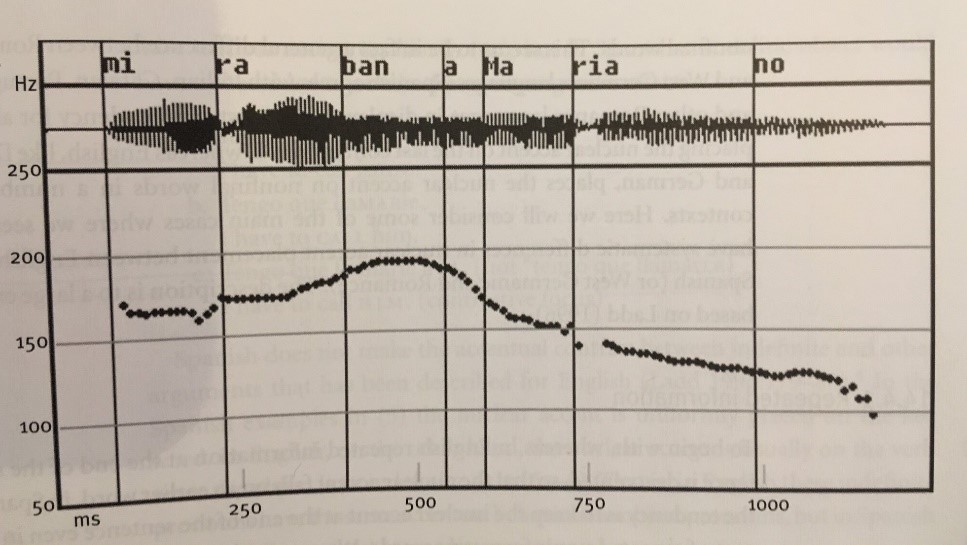Teaching Spanish Pronunciation
3. Stress, rhythm and intonation
3.4. What is intonation?
Pitch variation is caused by the rise and fall of the voice when we speak. Phonetically speaking, pitch is determined by the rate of vibration of the vocal folds; the faster they vibrate, the higher the pitch. In all languages, pitch variation is used for linguistic purposes. In many languages (e.g. Chinese, Vietnamese) pitch is used to differentiate words or grammatical meaning. For instance, in Mandarin Chinese, ma pronounced in a high tone means mother, while if it is pronounced in a circumflex tone (high-low-high) it means horse. These are examples of tone languages. Pitch in Spanish and English does not differentiate word meanings, it is employed to convey discourse-related meanings. That is, different pitch contours specify different types of utterances (e.g. question vs. statement) and are spread over the whole utterance, whether it be short or long. Such a use of pitch is called intonation. Intonation – generally in combination with tempo – is also used to express emotions. The expression of emotions also varies between cultures, and it is worth practising, or at least practising interpreting our interlocutors’ emotions. In this course, we will focus on the pragmatic meanings of intonation only.
Basic intonation patterns in Spanish
In both Spanish and English, there are two main turning points or signposts for the realisation of intonation; lexically stressed syllables and ends of phrases. Tonal contours associated with stressed syllables are known as pitch accents. In Spanish, in neutral declarative sentences, the last pitch accent is generally perceived as having greater prominence than the preceding accents, despite the fact that it normally has a smaller actual rise in pitch. Linguists call this pitch accent the nuclear accent of the phrase (indicated by small capitals in the examples below), and the other pitch accents of the phrase are called prenuclear accents.

Miraban a Mariano (They were watching Mariano). An example of a declarative with falling nuclear accent. Notice the displacement of the prenuclear peak to the posttonic. (Hualde, 2005: 257)
Simple declarative sentences in Spanish and English have a falling contour overall. In Spanish they have a fairly low pitch until the first stressed syllable where it rises rapidly, in English this rise is less abrupt.
As mentioned above, intonation may convey affection and other contextual meanings, therefore, the same sentence may be pronounced with a huge variation in intonation contours depending on the circumstances of the conversation. For example, intonation will vary when expressing incredulity versus certainty. Here we focus only on the main sentence types.
Interrogative sentences
The intonation contour of questions in Spanish, in general, moves in a wider pitch range than that of declarative sentences. Two main types of questions are distinguished; (i) yes-or-no questions and (ii) question-word questions.
Neutral question-word questions in Spanish have a falling contour similar to that of declarative sentences, with the highest point on the question word. If the question is not completely neutral e.g. there is an added pragmatic meaning such as politeness or insistence, the intonation contour might be different. In English, typically, there is a rising intonation on the question word and a falling intonation at the end of the question.
As for yes-or-no questions in Spanish, unlike in English, intonation may be the only linguistic feature that differentiates them from statements. These questions in most Spanish varieties have a final rise from a low point on the last stressed syllable.
Not only is there considerable variation in intonation across different contexts, but also across different regions of the Spanish-speaking world.
Activity
Visit the webpage Atlas interactivo de la entonación del español (link below). What is the example sentence for the exclamative sentence produced by a speaker from Bogotá?
This tool is very useful if you
want to illustrate a teaching point or just check the intonation of different
sentence types in different places. You can search by region, sentence type
(e.g. declarative sentence, wh-question, etc.) and choose a neutral or marked
sentence.
http://prosodia.upf.edu/atlasentonacion/
You can check your answer in Section 6.
